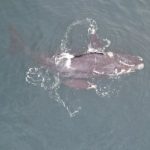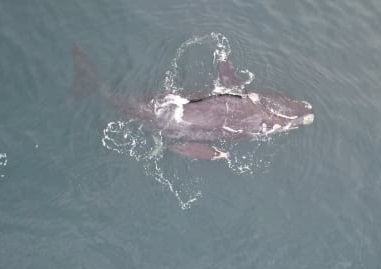 The first southern right whale and calf captured on camera this season in NSW is adding to the conservation of their species as part of project helping marine mammal experts identify individual whales.
The first southern right whale and calf captured on camera this season in NSW is adding to the conservation of their species as part of project helping marine mammal experts identify individual whales.
National Parks and Wildlife Service NPWS Marine Team Project Officer Andrew Marshall said the Right Whale ID Program, now in its second year, is using highly trained volunteer drone operators to photograph the unique white head-markings on each southern right whale.
“We are coordinating the collection of highly prized images of these rarely seen marine mammals so we can identify them individually.
“The latest addition to the collection is the exciting capture of a mother and newborn calf off Cronulla over the weekend by one of our trained volunteers.
“Unlike humpback whales who are built for speed, southern right whales prefer to hang around our sheltered beaches and bays a little longer at this time of year.
“But it is a rare treat to see one of these endangered animals, with fewer than 300 southern right whales migrating up the south east coast each winter.
“We currently have sightings of three different mothers and calves along the NSW coast.
“Additionally, volunteers in the program have captured a group of adults that have been in the Twofold Bay area for two weeks.
“This citizen science program will not only help to better estimate population size but also identify the species preferred areas to rest, give birth and care for calves.
“The more we understand about these animals, the more effective we can be in our conservation actions.
“Our highly skilled, CASA registered and NPWS trained drone operators are located up and down the NSW coast.
“As soon as we hear of a sighting, we ask one to fly over and photograph the whale from 100 metres above,” Mr Marshall said.
“We’re very grateful to our partner organisations ORRCA, Marine Rescue and Surf Life Saving NSW, who frequently help in sharing reports and sightings which contribute to coordination of pilot tasking.
“These images are assessed and we record individual head markings, all while hoping to recognise a whale from last year’s migration.
“All drone operators, whether part of this program or not, must keep the drone at least 100 metres away from the whale in all directions, including overhead.
“If people see a southern right whale please call 13000PARKS or the ORRCA Hotline 02 9415 3333 and relay details of the sighting so we can trigger a Right Whale ID response,” Mr Marshall said.
The Right Whale ID Program is funded by the NSW Marine Estate Management Strategy and is supported by the NSW National Parks and Wildlife Service.




















